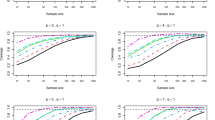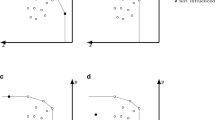Abstract
This paper proposes a statistical approach to handle the problem of detecting influential observations in deterministic nonparametric Data Envelopment Analysis (DEA) models. We use the bootstrap method to estimate the underlying distribution for efficiency scores in order to avoid making unrealistic assumptions about the true distribution. To measure whether a specific DMU is truly influential, we employ relative entropy to detect the change in the distribution after the DMU in question is removed. A statistical test has been applied to determine the significance level. Two examples from the literature are discussed and comparisons to previous methods are provided.
Similar content being viewed by others
References
Anderson, P., & Peterson, N. C. (1993). A procedure for ranking efficient units in data envelopment analysis. Management Science, 39(10), 1261–1264.
Banker, R. D. (1993). Maximum likelihood, consistency and data envelopment analysis: a statistical foundation. Management Science, 39(10), 1265–1273.
Charnes, A., Cooper, W. W., & Rhodes, E. (1978). Measuring the efficiency of decision making units. European Journal of Operational Research, 2(6), 429–444.
Charnes, A., Cooper, W. W., & Rhodes, E. (1981). Evaluating program and managerial efficiency: an application of data envelopment analysis to program follow through. Management Science, 27(6), 668–697.
Cook, R. D., & Weisberg, S. (1982). Residuals and influence in regression. New York: Chapman and Hall.
Cooper, W. W., Seiford, L. M., & Tone, K. (2000). Data envelopment analysis: a comprehensive text with models, applications, references and DEA-solver software. Dordrecht: Kluwer.
Cover, T. M., & Thomas, J. A. (1991). Elements of information theory. New York: Wiley.
Efron, B. (1979). Boostrap methods: another look at the jackknife. Annals of Statistics, 7, 1–26.
Efron, B. (1982). The jackknife, the bootstrap and other resampling plans. Society for Industrial and Applied Mathematics.
Efron, B., & Tibshirani, R. (1993). An introduction to bootstrap. New York: Chapman and Hall.
Fare, R., Grosskopf, S., & Pasurka, C. (1986). Effects on relative efficiency in electric power generation due to environmental controls. Resources and Energy, 8, 167–184.
Farrell, M. J. (1957). The measurement of productive efficiency. Journal of the Royal Statistical Society A, 120(Part iii), 353–281.
Kullback, S. (1999). Information theory and statistics. New York: Wiley.
Pastor, J. T., Ruiz, J. L., & Sirvent, I. (1999). A statistical test for detecting influential observations in DEA. European Journal of Operational Research, 115, 542–554.
Seaver, B. L., & Triantis, K. P. (1989). The implications of using messy data to estimate production-frontier-based technical efficiency measures. Journal of Business and Economic Statistics, 7, 49–59.
Sherman, H. D. (1988). Service organization productivity management. Canada: The Society of Management Accountants of Canada.
Simar, L., & Wilson, P. W. (1998). Sensitivity analysis of efficiency scores: how to bootstrap in nonparametric frontier models. Management Science, 44(1), 49–61.
Simar, L., & Wilson, P. W. (2000). Statistical inference in nonparametric frontier models: the state of the art. Journal of Productivity Analysis, 13, 49–78.
Venables, W. N., & Ripley, B. D. (1996). Modern applied statistics with S-Plus. Berlin: Springer.
Wilson, P. W. (1993). Detecting outliers in deterministic nonparametric frontier models with multiple outputs. Journal of Business and Economic Statistics, 11, 319–323.
Wilson, P. W. (1995). Detecting influential observations in data envelopment analysis. Journal of Productivity Analysis, 6, 27–45.
Xue, M., & Harker, P. T. (2002). Note: ranking DMU’s with infeasible super-efficiency DEA models. Management Sciences, 48, 705–710.
Zhu, J. (2001). Super-efficiency and DEA sensitivity analysis. European Journal of Operational Research, 129, 443–455.
Author information
Authors and Affiliations
Corresponding author
Rights and permissions
About this article
Cite this article
Yang, Z., Wang, X. & Sun, D. Using the bootstrap method to detect influential DMUs in data envelopment analysis. Ann Oper Res 173, 89–103 (2010). https://doi.org/10.1007/s10479-009-0520-9
Published:
Issue Date:
DOI: https://doi.org/10.1007/s10479-009-0520-9




